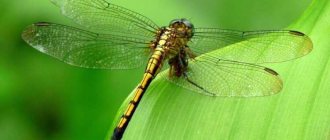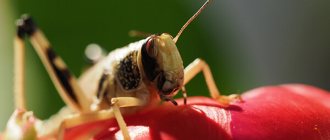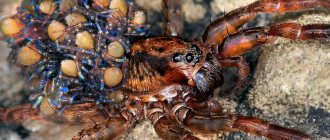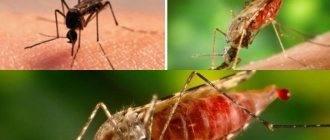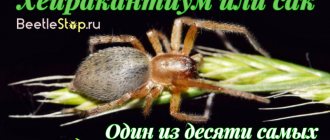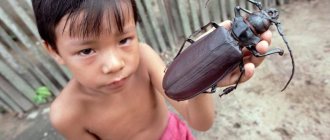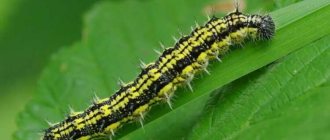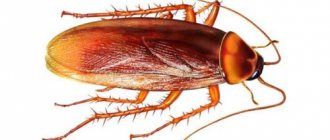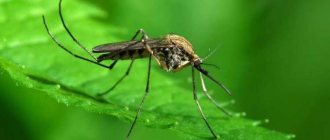Review author: “ZooVita”
Along with mosquitoes, horseflies are recognized as one of the most ancient insects. According to the species classification, they are assigned to the family of blood-sucking insects, which indicates the feeding nature of these representatives.
The specific name “horsefly” does not mean that the fly has poor vision. In fact, this term reflects what the horsefly does when bitten (freezes). Photos of horseflies presented in entomological collections will allow you to get acquainted with the structural features of representatives of the family.
General characteristics of the horsefly insect
The horsefly insect has a fairly large, developed body. The thoracic region and massive wings with a large span are clearly defined. A detailed description of what a horsefly looks like:
- The size of an adult reaches 2-3 cm (depending on the subspecies and habitat).
- Wide but slightly flattened abdomen, which consists of 7 segments. All segments are connected to each other by a thin membrane with excellent elasticity. It is due to the stretching of the membranous tissue that flies can absorb large amounts of blood.
- The characteristic difference between a female and a male is the shape of the abdomen. In males, the abdomen has a pointed end; in females, it is characterized by a rounded shape.
- Behind the chest there is a shield - a plate of chitinous tissue that performs a protective function.
- All horse flies have wide wings, which can be transparent, have colored spots on the surface or have a mesh pattern.
- Under the wings there are halteres, which are rudimentary formations. In the process of species development, horseflies lost their second pair of wings, but found use for the remaining processes. Today, the role of the rudiment in the navigation of horse flies during flight has been proven.
- All three pairs of limbs are covered with a continuous layer of hard hairs. At the ends of the legs there are three pairs of suckers and two claws, which allow flies to stay on vertical surfaces.
- The structure of the eyes deserves special attention. The horsefly's visual organ consists of many facets, visual cones. Thanks to the excellent innervation of the eyes, horseflies perfectly see the contours of objects and the slightest movements. Some individuals have additional eyes of a simple structure.
- The olfactory organ is represented by thin antennae located between the eyes.
The oral apparatus has the form of 6 plates, which are arranged in a fan. Females have paired jaws; with macro photography, you can see their resemblance to sharp sabers. There are tentacles on the lower jaws.
Some members of the family acquired additional devices: suction cups on the nose, stilettos for cutting rough skin, porous tissue resembling a sponge (allows it to absorb flower nectar).
All structural features of the horsefly are aimed at maximizing the adaptation of the insect to any environmental conditions.
How to protect yourself from horsefly bites?
#1 . Like many other insects, horseflies are sensitive to the pungent odors of certain strong-smelling plants . Among them are mint, geranium, marigold and others. They can easily beautify your garden plot, so that at least you can relax there more peacefully.
#2 . When going into nature , stock up on suitable anti-horsefly remedies . As a rule, any repellent sprays or ointments that repel insects will do. Here the choice is yours!
#3 . Dress appropriately for the setting . Try to keep your body covered when going out into nature, where there are a lot of horse flies. Even if it's hot, you can always wear light, well-ventilated clothing to protect yourself from these pesky insects.
#4. If the area is heavily populated with bloodsuckers, purchase horsefly traps . You can either buy them ready-made or make them yourself. This is especially true if you frequently visit a summer cottage or if there is a massive attack of horseflies when grazing domestic animals.
Habitat of the insect horsefly
Horseflies are widespread everywhere, excluding the territory of Antarctica, Greenland and some islands of the Arctic Ocean.
They prefer to settle in places with very high humidity, which corresponds to the metabolic characteristics of insects. You can meet horseflies near swamps, ponds, forests, and pastures.
What to do if bitten by a horsefly?
Often a horsefly bite overtakes us in nature, far from home. Anticipating this, you should always take with you both insect bite repellents and ointment sprays that relieve itching and irritation . It doesn’t hurt to take some antiseptic . It will always come in handy on vacation.
If bitten by a horsefly:
- wash the bite area with clean cold water;
- disinfect with an antiseptic (alcohol, peroxide, etc.);
- If possible, apply a cold compress to reduce pain and irritation.
- If there is ointment for insect bites, then apply it.
As a rule, this is enough. The main thing is not to scratch the bite site, no matter how much you want to do it . Otherwise, you can get an infection and make the situation worse.
Transmission of infectious diseases through a horsefly bite is a fairly rare occurrence . However, it should not be completely excluded. If you experience an increase in temperature, general malaise, chills and other signs of infection, it is better to check with a doctor and rule out the possibility of developing the disease.
Horsefly diet
By analogy with mosquitoes, only females feed on the blood of humans and animals. Male individuals feed on flower nectar, plant juices and the liquid secreted by aphids.
A characteristic detail: females can consume plant foods, but blood is needed as a source of protein during the period of laying eggs. Not only humans and cattle, but also birds, lizards, and monkeys can become victims of horsefly.
Horsefly: harm to humans
Horseflies often attack not only livestock, but also humans. The pain at the site of the bite is very severe due to the poison that enters the blood. The bite site may swell if a person is allergic to the bites of blood-sucking insects, and poison and other toxic substances not only poison the body, but also prevent blood clotting - in other words, the wound will not heal so quickly.
Another consequence of a bite can be infection - in this case, after the bite, the temperature rises and general malaise occurs, which means that the victim should immediately consult a doctor.
The importance of the horsefly insect for epidemiology
Like most blood-sucking insects, horseflies are subject to control by epidemiologists. Flies are carriers of a number of infectious diseases:
- Anthrax. The development of this particularly dangerous infection is associated with the feeding habits and habitat of horse flies. Anthrax spores are widespread in livestock burials and in the soil of pastures.
- Tularemia is a disease that is often fatal.
- Q fever.
- Loiasis is a helminthiasis transmitted primarily through blood.
Due to the special importance of horseflies in the transmission of a number of infections, today there is a continuous fight against the proliferation of insects (disinfestation) in fields, in low-lying water bodies, and in pastures.
Why are they dangerous?
The pain from the bites caused by feeding females will seem like nonsense compared to the possible consequences. The oral apparatus of adults is of the piercing-cutting type. In order to calmly drink blood, when a horsefly bites, it injects an anticoagulant into the blood. If a person is allergic to insect saliva, it can lead to anaphylactic shock.
If you remember what horseflies eat, you won’t be surprised that they are carriers of extremely dangerous diseases for humans: tularemia, anthrax, trypanosomiasis, filariasis.
Life cycle of horsefly
Horseflies belong to a group of insects with a full cycle of transformations:
- Egg stage.
- Larval stage.
- Pupa stage.
- Imago stage.
Female horse flies are highly fertile, laying up to 100 eggs at a time. During its life, with a sufficient amount of blood, an adult can repeat 4-5 egg laying cycles. The maturation of the masonry occurs over 4-8 days.
After emerging from the egg shell, the horsefly larva enters water or wet layers of soil and moss. The horsefly larva feeds on the remains of organic tissue; some representatives are predators already at this stage.
During the cold season, the larvae can remain in the ground for a long time without danger of damage. The fly pupa resembles a butterfly pupa in shape and is covered with spines and stiff hairs. As it grows and matures, the shell changes color several times.
Reproduction
Reproduction of this insect occurs in the summer. First, the dipterans mate, then the fertilized female lays eggs on the surface of the water. During fertilization, the female actively feeds on the blood of animals in order to create active offspring.
One female can lay up to a thousand oblong-shaped eggs. In general, the life span, including the period of the larva and until the formation of the imago (adult horsefly), is about four years.
Main types of horseflies
Today there are about 200 species of horseflies:
Horsefly - raincoat
The outer cover has an ash color, and the wings have a marble pattern.
Bullfly
Is the most common representative. The body is brown with yellow stripes, dotted with hairs. A characteristic feature is the presence of yellow or gray spots on the abdomen.
Forest lacewing
The compound eye received its interesting name for its original coloring. You can recognize a forest insect by the presence of a V-shaped pattern on its abdomen.
Among the most famous species, one can also note the common lacewing (the habitat differs) and the great gray horsefly.
Treatment of bites: anti-bite therapy
Treatment of a gadfly (horsefly) bite with medications is carried out more often in cases where first aid was not provided and when disinfectants were not used. And - when the insects managed to implant the larvae under the skin.
In the first case, this is local therapy with anti-inflammatory ointments, compresses, systemic therapy in case of allergies, multiple edema, fever, rashes, enlarged lymph nodes, indicating an intense inflammatory process.
So, for allergies, large edema, antihistamines are used, for severe edema, infiltration, glucocorticoid anti-inflammatory ointments are used (as an option - based on hydrocortisone, prednisolone, etc.).
To reduce swelling from a bite without signs of inflammation, heparin and other drugs are used; to reduce itching, lotions with diphenhydramine, specialized ointments, and gels are used to treat the consequences of bites of winged pests.
In the second case, if suppuration is observed, if larvae were presumably deposited under the skin, the lesion is opened, the affected tissue is removed, and appropriate anti-inflammatory therapy is carried out.
How to treat a horsefly and gadfly bite: folk remedies
How to anoint a horsefly bite, what compress to apply if your arm or leg is itchy and swollen:
- Compresses and lotions from soda: 1 tbsp. for 1 liter of water – apply for 2-3 hours;
- Vinegar compress 70-100 g per 1-1.5 l - apply if the horsefly bite is itchy or itchy;
- Tincture of calendula (compress), propolis – anti-inflammatory agent;
- Grinded onion pulp (compress) or cut, potato, garlic: distracting effect, relieves swelling, itching.
Means and methods of protection
- In places where horseflies accumulate, use repellents, protective sprays, lotions and other products.
- Repellent effect: mint, wormwood, tansy, aromatic oils (cloves, lavender, citrus, etc.).
- It has been proven that horseflies are attracted to the dark color of the victim: wear light-colored clothes.
- Horseflies prefer a damp surface for landing: this is important to take into account when resting near bodies of water.
- When attacking, it is important to freeze in place: the insect stops the attack, but resumes it when moving.
Let's hope that our short excursion will help to distinguish between the bite of a gadfly and a horsefly, choose means of protection and dispel all questions about what to do in the event of an insect attack.
Photos of all types of insect horsefly
Why is horsefly called this way?
To this day, many people argue about where the word “horsefly” itself came from. Some believe that the insect received this name as a result of the fact that it often tries to bite a person or animal in the eye. As if he wants to blind his victim.
horsefly lacewing
It is also widely believed that the horsefly began to be called so because of its striking behavior. During an attack and when biting, this insect is so obsessed with the thirst for blood that it does not notice anything. Thus, it behaves as if it sees poorly - as a result, it can be easily killed or simply removed by hand from the animal to which this parasite has attached itself.
But in fact, the horsefly has good eyesight, which helps it find food and hunt. A number of entomologists even claim that this flying bloodsucker notices prey at a distance of about 1000 meters. True, horseflies see mainly the outlines of objects and react to their movement. For this reason, horseflies often mistake their prey and go after a car, boat or train.
Horseflies pose a great danger to humans due to the fact that they are carriers of dangerous diseases, since they feed on the blood of rodents, birds and dead animals.
Interesting facts related to the lifestyle of the bullfly
Adult insects of this species do not feed. Adults spend most of their time in flight, guided by vision.
Female horse flies react to large moving objects. Therefore, they often choose cars or boats as their victims and begin to chase them. The speed of a moving object can reach 40 kilometers per hour. Moreover, horseflies will pursue a boat that has sailed several hundred kilometers from the shore!
Experiments have proven that horseflies do not attack striped objects. Apparently, this is due to the structure of their visual organs. What confuses them especially is the fact that the stripes are not parallel. Zebras that have exactly this color practically do not suffer from horsefly attacks.
Not just bitten - infected with a disease!
The bullfly is an extremely harmful insect. In addition to the fact that this bloodsucker annoys cattle with its bites, it spreads various diseases. This includes tularemia, anthrax, filariasis, trypanosomiasis, and polio.
The bull horsefly does not hesitate to taste the blood of three-day-old corpses. And this is even worse than the transfer of infection from one living being to another. After all, if an animal died precisely as a result of a fatal disease, then there is no guarantee that the insect will not infect a person or livestock with it.
Meaning in nature
Many people, especially rural residents, who are bothered by these evil blood-sucking flies and interfere with the breeding of livestock, have a question: why not lime the bullfly at all? But it turns out that this is absolutely impossible to do. After all, this insect, like all others, is a component of natural communities. By wiping it off the face of the Earth, the established balance can be disrupted. This will definitely have a negative impact.
In fact, horseflies serve as food for dozens of groups of animals: birds, fish, reptiles. It is not without reason that many fishermen use this particular insect as bait. And quite successfully, by the way.
The corpses of insects, falling to the ground, fertilize it, which is also one of the reasons for the inexhaustibility of our soils.
Another question: how to reduce the harm caused by this vile? As it turns out, horseflies cannot tolerate the smell of wormwood. Therefore, it is recommended to hang bunches of this fragrant grass on door jambs and window frames during the period when these insects are especially active (June-July). It is unlikely that there will be a horsefly who dares to overcome such an obstacle.
In barnyards, in order to reduce the number of bloodsuckers, they arrange special reservoirs for them, pouring a little fuel oil or kerosene into them. Insects, trying to get drunk while flying, cannot take off and fall into a puddle where they die.
People who are forced to do things in the garden or yard at noon, graze animals in pastures or do work in the fields use chemical repellents as protection against bites. Clothing made of thick fabric also helps them. The face is protected with a hat with a net, such as beekeepers usually use.
Spread of the bullfly
This is one of the most tenacious creatures on Earth. The bullfly is an insect that lives in almost all corners of Eurasia and even in Africa - in the north-west of the continent. It can be found even in the mountains, 2 km above sea level. There are no horse flies only, perhaps, in places of permafrost and in a desert completely devoid of vegetation.
And this happens because the bullfly, whose habitat is the edges of forests, pastures, and the shores of water bodies, is capable of producing offspring in huge numbers in one season.
Description and habitat
Horseflies are flying arthropod insects from the Diptera family. It is most active in wetlands and agricultural areas where livestock are raised.
Externally, the horsefly looks like a large fly about 2 cm in size; natural shades predominate in color - gray, brown. Looking at the appearance of the gadfly, you can see eyes that change color, impressive sharp mouthparts and a fleshy proboscis.
The horsefly has a slightly elongated body with a thin chitinous covering. Behind the transparent wings there are halteres, thanks to which the insect can balance during flight and make characteristic sounds.
Consequences of a bite
The consequences of a gadfly bite are swelling, allergies. Pregnant women may experience fetal death, premature birth, or miscarriage.
Infection of a wound can contribute to the development of an inflammatory and infectious process, including blood poisoning (sepsis) and bacteremia (high levels of bacteria in the body).
Tetanus and gas gangrene may develop.
Allergic reaction
A person who is bitten by an allergy may experience an attack of suffocation or anaphylactic shock. Maybe even coma, and then death.
Where does horsefly live?
Photo: Insect horsefly
Horseflies usually live in forests. The species typically feeds during the day and is most visible on calm, hot, sunny days. They are commonly found in both suburban and rural areas near bodies of water that serve as breeding grounds and where mammalian hosts are most abundant.
The larvae develop in the gastrointestinal tract of host animals during winter. At the end of winter and at the beginning of the spring months, adult larvae are found in the host's feces. From there they burrow into the soil and form a puparia from the skin of their last instar (instar) larvae. They develop into adult flies inside the puparium and emerge after 3-10 weeks.
Adults are active from mid-summer to autumn. Adult females lay eggs on the hair of horses, especially on the hair on the front legs, but also on the belly, shoulders and hind legs. The eggs hatch in 10–140 days with the proper stimulus (moisture, heat, and friction) caused by the horse licking or biting egg-infected hair.
The tiny first instar (instar) larvae enter the mouth and burrow into the tongue for approximately 28 days before they molt and move into the stomach where they remain for 9-10 months, developing into the third instar after approximately 5 weeks. One generation of horse flies grows up per year.
Are horseflies and gadflies the same thing?
Of course not. These are different insects that also belong to different families. Gadflies and horse flies differ:
- structure;
- appearance;
- behavior;
- characteristics of reproduction;
- nutrition (for example, adult gadflies, unlike horseflies, do not need food at all and do not drink blood);
Therefore, those people who call horse flies gadflies are greatly mistaken. Although both of these insects are unpleasant and dangerous. They must be fought. Moreover, every farmer, gardener, fisherman, hunter and traveler should know how to protect themselves from such blood-sucking reptiles.
Features of character and lifestyle
Photo: Bullfly
Adult horseflies are fast, strong fliers, capable of flying more than 48 km, although they do not usually spread widely. Most often they attack moving and dark objects. Horseflies often rest on paths and roads, especially in forested areas, where potential hosts await them. Flies are attracted to light and sometimes congregate in windows. Horseflies are more common in hot, sunny weather with little wind, such as during the daytime in midsummer. They can become more of a pest when thunder accompanies hot weather.
Horseflies are diurnal, meaning they are active during the day. They prefer to feed on the blood of livestock such as cows and horses. This can be problematic because horse flies carry pathogens that can cause disease in some livestock species, leading to potential economic losses. And unfortunately, horseflies have no problem feasting on people or pets if given the opportunity.
Fun Fact: Like other blood-sucking insects such as mosquitoes, female horse flies use both chemical and visual cues to locate their hosts. Carbon dioxide emitted by warm-blooded animals provides a long-range signal to attract flies at a distance, while visual cues such as movement, size, shape and dark color serve to attract horse flies over shorter distances.
